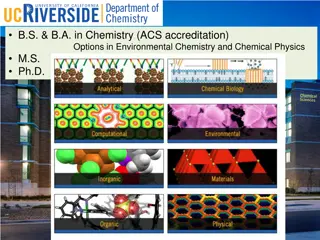
Understanding Chemistry: Energy Levels and Orbitals
Dive into the world of chemistry with a focus on energy levels, ionization energies, sub-shells, and orbitals. Explore how electrons are arranged in shells, sub-levels, and orbitals around the nucleus of an atom. Understand the concept of principle quantum numbers and the different shapes of orbitals, as well as how they relate to electron configuration and energy states within an atom.
Download Presentation

Please find below an Image/Link to download the presentation.
The content on the website is provided AS IS for your information and personal use only. It may not be sold, licensed, or shared on other websites without obtaining consent from the author. If you encounter any issues during the download, it is possible that the publisher has removed the file from their server.
You are allowed to download the files provided on this website for personal or commercial use, subject to the condition that they are used lawfully. All files are the property of their respective owners.
The content on the website is provided AS IS for your information and personal use only. It may not be sold, licensed, or shared on other websites without obtaining consent from the author.
E N D
Presentation Transcript
Evidence of Shells The energy required to remove an electron from an atom is called the ionisation energy . Successive ionisation energies increase in size as the +ve nucleus has a greater pull on the remaining electrons. 8 e-in shell 2 Maximum Electrons Per Shell 7 e-in shell 3 1stShell 2 2 e-in shell 1 2ndShell 8 3rdShell 18 Nuclear attraction decreases with shell distance. 4thShell 32 Successive Ionisation of Chlorine (17 electrons: 2, 8, 7) 5thShell 50 Rather than a consistent rise in successive ionisation energies, there are jumps representing electrons within a new shell. The closer a shell to the +ve nucleus the more energy required. Jumps also show the total number of electrons each shell holds.
Evidence of Sub-Shells The first ionisation energy of elements reveal minor jumps as the shells are further divided into sub-shells. Large drop = new shell 1stsmall drop = 1stsub-shell 2ndsmall drop = 2ndsub-shell half filled
Energy Levels & Sub-Shells Electrons further from the nucleus are in a higher energy state. So it is better to think of shells as energy levels. SUB LEVELS PRINCIPAL ENERGY LEVELS f d 4 INCREASING ENERGY / DISTANCE FROM NUCLEUS p s The lowest energy state in any energy level is the s sub-shell. Then p, d and f sub-shells respectively. d 3 p s Some people don t fart. p 2 s Naming sub-shells: e.g. second sub-shell in third energy level would be: 3p Principle quantum number (energy level) 1 s Sub-shell
Modelling Orbitals An orbital is a region around the nucleus that can hold up to two electrons, with opposite spins . i.e. where it is likely to find an electron within an energy level. Each sub-shell type contains a different number of orbitals. Sub-shell Maximum Electrons Number of Orbitals Different types of orbitals also have different shapes. s 2 1 p 6 3 d 10 5
Orbital Summary The higher the principle quantum number the larger the size of the orbital i.e. further from the nucleus. S-orbitals are spherical and p-orbitals are dumbbell shaped. 3 p-orbitals are arranged on three separate axes one along the x, one along the y and the third along the z.
Filling Orbitals The rules: 1. Fill from the lowest energy level available. 2. Two electrons can be in an orbital but must have opposite spin. 3. Only pair up electrons if no other orbitals are present. Electrons repel each other so being in separate orbitals means less repulsion and therefore more stable. Hydrogen = 1 electron Helium = 2 electrons Nitrogen = 7 electrons 3d INCREASING ENERGY 3 3p 3s 2p 2 Half arrows ( ) are used to represent one electron and to show its direction of spin. 2s 1 1s
Filling Orbitals Use the grid method to show how the orbitals fill for: D Mild: Y Warm: I Hot: Lithium, Carbon, Fluorine, Magnesium. Phosphorus, Silicon, Argon, Chlorine. Ions of: Lithium (Li+), Oxygen (O2-), Nitrogen (N3-), Aluminium (Al3+).






















